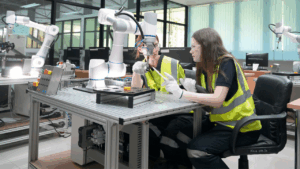“A Demographic Profile of the Canadian Environmental Workforce”- newest ECO Canada ‘s release on the detailed profile of the Canadian green workforce.
Calgary, AB, June 3d, 2024 – ECO Canada has released a new report titled “A Demographic Profile of the Canadian Environmental Workforce,” providing a comprehensive overview of the demographics and characteristics of professionals working in the environmental sector across Canada.
Canada needs a large and skilled environmental workforce to achieve its goal of sustainable economic growth. Our latest environmental labour market outlook report estimates that 7% of Canada’s workforce participated in or supported environmental protection, natural resource management or sustainability activities in 2023, and more than 480,000 new green workers will be required over the next decade.
Employers looking for skilled environmental workers report that labour and skill shortages are already impacting their organizations and expect greater challenges in the future. To find the workers they need, employers will need to explore all available sources of talent and encourage diversity in the workplace.
“The consequences of climate change are unprecedented for our population, the environment, and our economy. By supporting research and reports like the one from ECO Canada, we are working together to face the challenges of today and tomorrow. These findings in the environmental sector will help us to address labour shortages and to achieve Canada’s goal of a net zero economy.” – Randy Boissonnault, Minister of Employment, Workforce Development and Official Languages.
Based on an extensive survey (conducted among employers and green workers in Canada in 2023) and a data analysis, the report offers valuable insights into the composition of Canada’s environmental workforce, including key demographic trends, educational backgrounds, and employment characteristics.
Report highlights include:
- Gender Diversity: While the environmental sector has made progress in gender diversity, with women accounting for 46% of the workforce, there is still room for improvement in achieving gender parity, particularly in leadership roles.
- Age Distribution: The report highlights a relatively balanced age distribution among environmental professionals, with a significant portion of the workforce aged between 25 and 44 years old.
- Educational Attainment: The majority of environmental professionals hold post-secondary education, with 75% possessing a university degree and 17% holding a college diploma or certificate.
- Employment Characteristics: The report examines various employment characteristics of the environmental workforce, including job satisfaction, salary ranges, and employment status.
The findings of the report have significant implications for the future of the environmental sector, highlighting the importance of continued education and training to meet evolving industry needs.
“The demographic profile of Canada’s environmental workforce provides valuable insights into the current state of the industry and the opportunities for future growth and development,” says Geni Peters, Director of research at ECO Canada. “It underscores the importance of diversity and inclusion in driving innovation and sustainability in the environmental sector.”
The full report is available for download on the ECO Canada website: A Demographic Profile of the Canadian Environmental Workforce – March 2024 | ECO Canada
This project was made possible by the Government of Canada’s Sectoral Workforce Solutions Program’s funding.

“The opinions and interpretations in the publication are those of the author and do not necessarily reflect those of the Government of Canada.”





